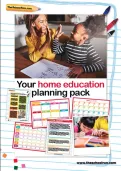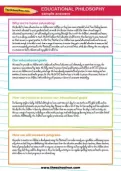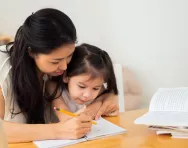Important update from TheSchoolRun
For the past 13 years, TheSchoolRun has been run by a small team of mums working from home, dedicated to providing quality educational resources to primary school parents. Unfortunately, rising supplier costs and falling revenue have made it impossible for us to continue operating, and we’ve had to make the difficult decision to close. The good news: We’ve arranged for another educational provider to take over many of our resources. These will be hosted on a new portal, where the content will be updated and expanded to support your child’s learning.
What this means for subscribers:
- Your subscription is still active, and for now, you can keep using the website as normal — just log in with your usual details to access all our articles and resources*.
- In a few months, all resources will move to the new portal. You’ll continue to have access there until your subscription ends. We’ll send you full details nearer the time.
- As a thank you for your support, we’ll also be sending you 16 primary school eBooks (worth £108.84) to download and keep.
A few changes to be aware of:
- The Learning Journey weekly email has ended, but your child’s plan will still be updated on your dashboard each Monday. Just log in to see the recommended worksheets.
- The 11+ weekly emails have now ended. We sent you all the remaining emails in the series at the end of March — please check your inbox (and spam folder) if you haven’t seen them. You can also follow the full programme here: 11+ Learning Journey.
If you have any questions, please contact us at [email protected]. Thank you for being part of our journey it’s been a privilege to support your family’s learning.
*If you need to reset your password, it will still work as usual. Please check your spam folder if the reset email doesn’t appear in your inbox.
Getting started with home education: your step-by-step guide



Free home education planning pack & resources
- Guidance, templates and advice to get you started
- Practical tips from experts and parents
- How to establish a routine and set learning goals
There's a lot to think about when you're getting started with home education, from working out what you're going to teach your child to finding the resources you'll need. Although most home-educating parents grow in confidence as time goes on, the first stages can be daunting. Our step-by-step guide walks you through those initial steps.
1. Remove your child from school
It sounds obvious, but removing your child from school – if they've already started – is the first step on your home education journey. You do this by writing to the head teacher and asking for their name to be removed from the register. If your child hasn't yet started school but you've accepted a school place for them, you'll need to give this up, usually by filling in a form that you can obtain from the local authority.
There's no obligation for you to tell the local authority that you're about to start home educating although they may contact you when they realise your child isn't registered at a school and ask what provision you've made for their education.
2. Join a home education group
This isn't compulsory, but it's a great idea for novice home educators, as you'll be able to pick the brains of people who've been doing it for a while. They can tell you where to go for resources and learning experiences in your area, share materials, provide group learning opportunities and give your child a chance to socialise with other home-educated children. Education Otherwise has a comprehensive list of groups throughout the UK.
3. Work out what approach you'll take
'If you had a hundred home educators in a room, each of them would be likely to have a different approach,' says Greg Smith, head of operations at Oxford Open Learning, which provides distance learning courses for home educating families. Teachers are skilled at educating lots of children at the same time, but home education is all about tailoring learning to suit you and your child. Generally, there are two methods – structured and autonomous – and most families find their own way between the two.
Structured learning is formal, using a timetable for lessons and a curriculum of subjects. If the plan is for your child to return to school, this might be a useful approach, keeping them familiar with the structure of school life. It could be helpful for a child with special needs who thrives on routine. Or, if you are home educating because your child is a gifted sportsperson and committed to a club, structured learning will be essential in order to fit lessons around training sessions.
Autonomous learning is flexible. It's child-led, allowing them to decide what, when and how to learn according to what interests them most. With this approach, you're more of a facilitator than a teacher, providing the opportunities, experiences and resources your child needs to follow their interests. If your child didn’t respond well to the structured school system and is self-motivated, this could work well depending on their age.
Writing an educational philosophy can help to clarify what sort of approach would suit you best.
4. Suss out your child’s learning style
This goes hand in hand with working out what approach you'll take to home education. Think about your child’s personality and how best they absorb and enjoy information.
Are they self-disciplined enough to come up with an idea of what they’d like to learn and follow it up, or do they manage better with workbooks at the kitchen table? Do they like to be active and learn better when they're hands-on, or do they like to make lots of notes, or have music on while they're working? Listen to your child as you learn with them – be prepared to stop frequently to answer their questions and keep a note of what interests them so you can adapt.
5. Devise a scheme of work
A scheme of work isn't essential, but it can be helpful, especially if you're taking a more structured approach to home education. This a plan that details how you're going to cover a particular topic. Involving your child in devising a scheme of work will help them feel involved and motivated.
Things to discuss include:
- What are your aims?
- What do you want to produce?
- What resources will you need?
- How long will it take?
6. Work out your 'working hours'
Not every home-educating family has a timetable, but it can help, especially in the early stages, while you're setting up a routine and encouraging good study habits. It can be a loose framework of subjects you intend to follow each day, or a more detailed hour-by-hour plan.
A typical school day runs from 8.50am until 3pm. The timetable includes literacy (English) and numeracy (maths) for about 70 minutes every day up until age 14 with weekly (or more regular) lessons such as science, geography, history, PE, religious education, art, music, drama, modern languages, computing, design and technology (woodwork, metalwork, textiles, food, graphics) and personal, social and health education.
There’s approximately an hour’s break for lunch plus 20 minutes in the morning and 15 minutes in the afternoon.
A home education timetable could be based on the above, depending on your child’s interests, attention span and any commitments such as home education groups or extra-curricular clubs that your child goes to. Perhaps you will spend a portion of the day away from home – meeting other home educators and their children; visiting a farm; going for a nature walk in the woods or listening to an afternoon music performance at the local church. Alternatively, you may decide not to follow a conventional school day, and instead do a shorter period of formal learning seven days a week, or start earlier in the morning and finish earlier, for example.
7. Invest in your equipment and tools
Some home educators argue the only tool you need is an enthusiastic parent, but some basic resources will make the experience easier. These include:
- Somewhere to work: this could be a desk in a room that's dedicated to your child's learning, or the kitchen table, depending on your space and approach to home education.
- A dictionary.
- An atlas.
- A pencil case, including a maths set and handwriting pen.
- Resources like paper (plain and lined), glue, felt tips, crayons and a stapler.
- A computer.
- Somewhere to store your child's work.
Avoid spending money too quickly (read out tips about home educating on a budget), but speak to other home educators about the books and resources they found most useful. Consider bulk-buying stationery with others, and don't invest too heavily in lots of resources for a particular topic: make the most of what's available online and in libraries and museums.
8. Familiarise yourself with good resources
There are lots of great educational resources for home educating families, many of them free. These include:
The library: for books, CDs, DVDs, reference material and computers. Don’t forget you can also order items if they're not in stock.
Your local council. Ask if it offers access to learning resources, sometimes based in schools or colleges. Depending where you live, you might also be entitled to a discount at local leisure centres or museums.
The Department for Education: you can access the National Curriculum and use it as a guide to what to teach your child and what they should be capable of by age, or just for inspiration.
Museums: mention that you are a home educator and you might get a discount.
The BBC offers school television programs and radio, from beginner’s Arabic to A Level maths, plus good educational resources online.
LETS: a local exchange system for people living near each other to swap goods and services.
Distance learning: there are a number of companies in the UK, such as Oxford Open Learning, offering educational support at varying costs – from sets of workbooks to resources for individual subjects to exam curriculums.
9. Keep on top of progress
For many parents, the aim of home education is for their child to follow their own learning development curve, whatever form or pace, but without formal assessments or other children to compare them to, it can be difficult to see if they're making progress.
You might, for example, notice your child’s ability to play more pieces on their musical instrument, remember new words in French or produce more detailed life drawings. If your child continues to ask questions as they learn, is confident, happy and enthusiastic about learning, then they are making their own progress.
If you're following a structured learning program, you can access the National Curriculum and follow your child’s progress that way. Regular self-assessment tests and assignments can help consolidate learning.
10. Adapt with your child
Unlike school life, which has to cater for the majority, home education means you can follow your child's lead. In time, you'll get to know what interests them and how and when they learn best, and can adapt what you're doing to meet their needs. Be prepared to be flexible, and you and your child will fall into a routine that works for you both.
For a complete beginner's guide to home education, with templates to help you devise an educational philosophy and a schedule, see TheSchoolRun's Home education planning pack.








